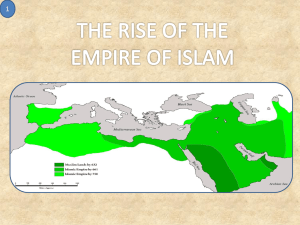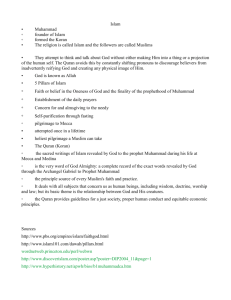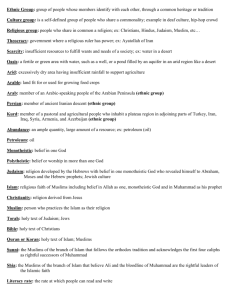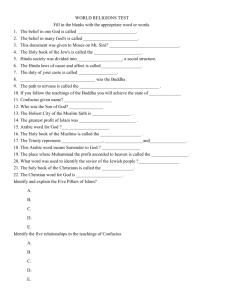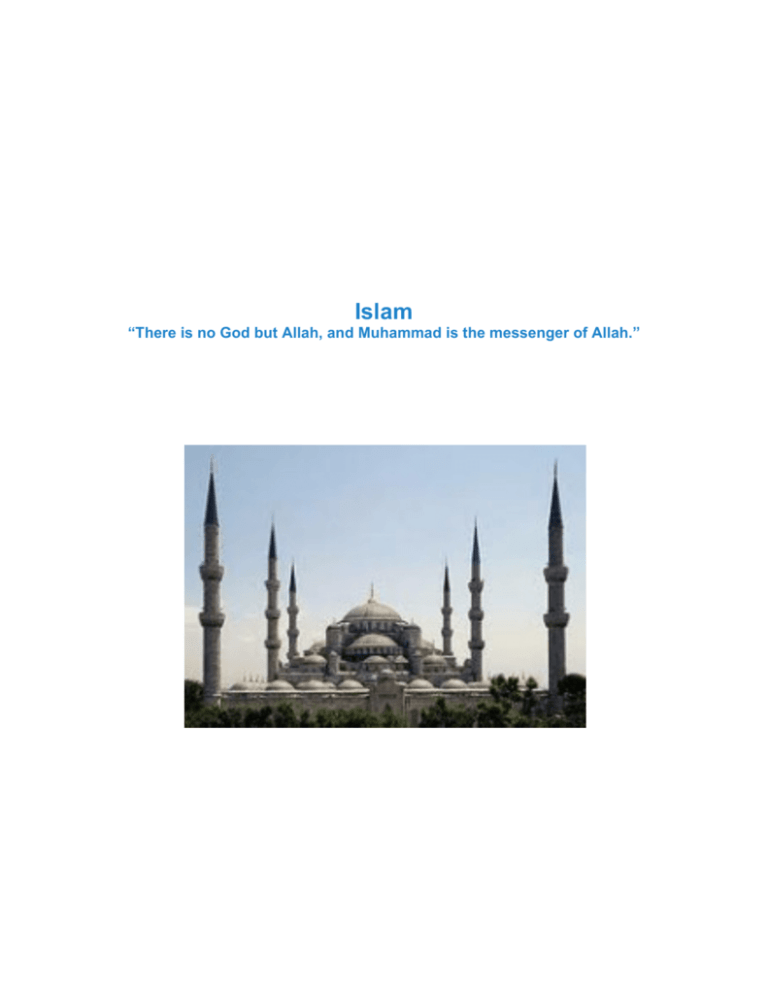
Islam
“There is no God but Allah, and Muhammad is the messenger of Allah.”
Islam
“There is no God but Allah, and Muhammad is the messenger of Allah.”
Prepared by Dara Weller
Goal
Introduce students to the Islamic religion and the spread of Islam. The
overarching goal is for students to find the commonality in the
monotheisms and gain an appreciation and tolerance for each religion.
Overview
Students in grades 7-12 will learn about the history and culture of Semitic
religions (i.e., the similarities and differences) and specifically Islam.
Additionally, they will understand and learn the history and geography of
the Ottoman Empire with the understanding that at one time the Ottoman
Empire was the most powerful empire in the world, the center of which was
located in what is now Turkey, and that it was declared the Muslim capital.
Objectives Students will
Research and present facts about the Semitic religions including
Islam.
Read the story of Abraham and discuss how Abraham is the father
of all three monotheisms. Discuss the connection between Abraham
and Islam.
Read about the life of Muhammad including his marriages, the
recitation of the Qur’an, the journey to Medina, and the subsequent
establishment of a Muslim community in Mecca; introduce the five
pillars of Islam.
Learn about the history and geography of the Ottoman Empire and
complete a map.
Materials
Mohammad: Legacy of a Prophet (PBS documentary can also
be found on You Tube).
Handout: MUHAMMAD, THE PROPHET OF ISLAM ca. 570 –632
C.E ©Council on Islamic Education, 2002 all rights reserved, may be
copied by educators for classroom use.
Computer with Internet access.
Encyclopedias and resource books
Resources about the Semitic religions.
A copy of the Shahada.
Calligraphy pens and ink.
Maps of Ottoman Empire using d-maps.com
Procedures
1. Explain that when we talk about Semitic religions, we are
referring to Judaism, Islam and Christianity. Features of
Semitic religions include a religion originating in the Middle
East and monotheism.
2. Read about Abraham. Discuss the role that Abraham plays in
Judaism, Christianity and Islam.
3. Divide the class into three groups representing Judaism,
Christianity and Islam. Each group must research and discuss
the role that Abraham plays in that religion. Each group
presents their work to the class.
4. Watch the documentary Mohammad: Legacy of a Prophet.
5. With students read the handout Mohammad, The Prophet of
Islam ca. 570-632 in Appendix A.
6. Divide the class into five groups. Each group will research one
of the following and share their findings with the class:
• Muhammad – the Early Years
• Muhammad’s Revelation
• Flight to Medina
• Life in Medina and Growth of Islam
• Muhammad’s Last Years
7. After procedures number 4-6, have students complete the
Muhammad Worksheet in Appendix B.
8. See Appendix C for extension exercises that accompany
discussion of the Five Pillars of Islam.
9. Use the Internet or resource books to study the Ottoman
Empire. Complete the map of the Ottoman Empire in
Appendix D.
Evaluation
Use the following three-point rubric to evaluate students' work during this
lesson.
Three points: Students were active in class discussions;
showed strong research skills; gave a concise, engaging
presentation; descriptions reflected a clear understanding of the
Semitic religions, Abraham, Muhammad, the Five Pillars of Islam
and the Ottoman Empire.
Two points: Students participated in class discussions;
showed strong on-grade skills; gave a competent presentation;
descriptions reflected a satisfactory understanding of the Semitic
religions, Abraham, Muhammad, the Five Pillars of Islam and the
Ottoman Empire.
One point: Students did not participate in class discussions;
showed weak research skills; presented their information with
difficulty; descriptions reflected a vague or inaccurate understanding
of the Semitic religions, Abraham, Muhammad, the Five Pillars of
Islam and the Ottoman Empire.
Standards
Mid-continent Research for Education and Learning (McREL)
McREL's Content Knowledge: A Compendium of Standards and
Benchmarks for K-12 Education addresses 14 content areas. To view the
standards and benchmarks, visit
http://www.mcrel.org/compendium/browse.asp.
The National Council for the Social Studies (NCSS)
NCSS has
developed national guidelines for teaching social studies. To become a
member of NCSS, or to view the standards online, go to
http://www.socialstudies.org/standards/strands/.
This lesson plan addresses the following thematic standards:
Comparative Religion
Culture
Time, Continuity, and Change
People, Places, and Environments
Appendix A MUHAMMAD, THE PROPHET OF ISLAM ca. 570 – 632 C.E.
MUHAMMAD, THE PROPHET OF ISLAM ca. 570 – 632 C.E.
©Council on Islamic Education, 2002 all rights reserved, may be
copied by educators for classroom use.
Muhammad (son of Abdullah) is known as “Prophet Muhammad” among
believers in the religion of Islam. According to Islamic teachings, he was the
last prophet, or messenger of God, who received revelation. When Muslims
mention Muhammad’s name, they ask God to bless him, as they do for other
prophets such as Adam, Abraham, Moses and Jesus. Muhammad was born
into the tribe of Quraysh, in the Arabian city of Makkah. Quraysh was the
tribe that took care of the sacred Ka’bah, or house of worship, and gave
water and food to pilgrims who visited it. Quraysh traced its ancestry to
Abraham and his son Ishmael, and believed they founded Makkah and built
the Ka’bah.
Muhammad’s father died before he was born and his mother died when he
was a child. Muhammad lived with his grandfather, and later his uncle, Abu
Talib. Abu Talib was generous but not wealthy, and taught Muhammad to
trade on their caravan journeys to Syria. A wealthy Makkan widow named
Khadijah employed Muhammad to sell her goods in Syria. She was so
pleased with his work that she asked him to marry her. For twenty-five
years, Khadijah and Muhammad were happily married. Their four daughters
lived to be adults, but two sons died.
Muhammad was did not like the idol- worship of the Makkans or the unjust
way the rich treated the poor, even members of their own tribe. He often
spent time in thought and prayer in a cave outside Makkah. There on the
Mountain of Light (Jabal al-Nur), Muhammad first experienced the call to
prophethood. Muhammad described how the Angel Gabriel awoke him and
told him to read. Muhammad replied that he could not read. Gabriel then
said, “Read (or recite) in the name of your Lord who created, created man
from a clinging clot.” (Qur’an, 95:1- 2) These were the first verses of the
Qur’an, the holy book of Islam.
Muhammad was about forty years old then. The experience frightened him,
and he hurried home, shivering, to his wife, who wrapped him in a blanket.
Khadijah reassured him that his search for truth would not lead him astray.
Her cousin Waraqah, a man of faith who knew the Christian holy books,
reassured them that Muhammad’s call to prophethood was true. He also
warned them that his own tribe would reject him.
After a while, Muhammad experienced more revelations. These new verses
told Muhammad to preach to his family. Members of Muhammad’s
household and immediate family accepted Islam, including his wife
Khadijah, the first Muslim woman. Later, he gathered members of his tribe
and warned them to believe in one God and turn away from worshipping
idols and unjust behavior. All rejected him except for his young cousin Ali,
son of Abu Talib. The earliest Muslims were mostly poor people, slaves and
women. Some important Makkans joined him, but most powerful leaders of
the Quraysh rejected him. His growing influence among the members of
Makkan society threatened their prestige and power. They bribed him with
offers of wealth and power, but he refused to give up. Quraysh persecuted
the Muslims and finally banished them to a dry valley and forbid anyone to
trade with them. This was a deadly boycott in a town without farming.
Khadijah and Abu Talib both died during the boycott. Muhammad sent a
small group of Muslims to Ethiopia to seek asylum, or protection from
persecution, which was granted by its Christian king, the Negus. . Quraysh
feared that Muhammad’s preaching against the idols would reach their
visitors during the pilgrimage, causing people stop visiting the Ka’bah.
Visitors from Yathrib, a city north of Makkah, did respond to Muhammad’s
teaching. Seeing the suffering of the Muslims, they pledged to protect
Muhammad and his followers in their town. Gradually, the Muslims left
Makkah. When Quraysh plotted to kill Muhammad, he and a close
companion, Abu Bakr, secretly left Makkah to join the Muslims in Yathrib.
Muhammad’s journey in 622 C.E.—called the Hijrah—marks the beginning
of the Muslim calendar. Yathrib was renamed Madinat an-Nabi, or “City of
the Prophet.” The people of Yathrib invited Muhammad to take over
leadership of the city. Muhammad drew up an agreement of cooperation
among the Muslims and the tribes. To help the refugees from Makkah, who
had left all that they owned behind, Muhammad joined each migrant from
Makkah (Muhajirun) in brotherhood with a Muslim from Madinah (Ansar).
This policy helped the refugees to begin new lives, and helped the new
Muslims of Madinah learn Islam from the experienced Muslims from
Makkah.
Muhammad’s successful escape from the murder plot enraged the Makkan
leaders. They had gained the wealth of the refugees, but they saw a greater
danger from the Muslims. Muhammad’s growing influence among the tribes
of Arabia might replace Quraysh’s leadership. They tried to weaken or
eliminate the Muslims. Throughout his time in Makkah, Muhammad had not
fought against Quraysh’s persecution. According to Islamic teachings, a
Qur’anic verse now told the Muslims to fight the Makkans. The first battle
came at the arrival of a Makkan caravan near the wells of Badr. Although
the Muslims were greatly outnumbered, they defeated the Quraysh in the
Battle of Badr. The Quraysh sought revenge in a second battle at Uhud,
where many Muslims and Quraysh died, but the outcome was a standoff.
Unable to defeat the Muslims as easily as they expected, Quraysh planned to
attack Madinah with the help of allied tribes. Instead of going out to meet
the attack, the Muslims fortified the city by digging a deep trench around an
undefended part of Madinah. The Makkans had never seen such a defense,
and were used to quick raids, but not siege warfare. During the Battle of the
Trench, Quraysh and their allies camped outside the trench and tried to break
through. After many of their allies lost patience and went home, the weather
turned bad, and Quraysh broke camp and returned home, humiliated. Their
prestige with local tribes was in serious trouble, and their economic power
was weakened by the threat to their caravans.
After the Battle of the Trench, Muhammad decided to make the pilgrimage
to Makkah. Although the Quraysh had the ancient duty to honor the
pilgrims’ peaceful intent, they stopped the Muslims at a place called
Hudaybiyyah, and denied them the right to visit the Ka’bah. Instead,
Muhammad succeeded in getting Quraysh to make a peace treaty. The treaty
allowed the Muslims to make pilgrimage the next year, and Quraysh agreed
to ten years of peace, at terms that seemed to benefit the Makkans. The
treaty was a victory for Muhammad, however, for three reasons: (1) The
Quraysh, after trying to exterminate the Muslim community, had been
forced to recognize it as a bargaining partner. (2) The Quraysh had failed in
its traditional duty by keeping Muhammad away from the Ka’bah, and was
already weakened by defeat in battle. (3) The treaty gave both the Quraysh
and Muhammad the right to make alliances with other tribes, and allowed
Muslim influence to grow unchallenged.
A short time later, the Quraysh broke the treaty. Muhammad marched an
army of thousands toward Makkah. Recognizing certain defeat, the Quraysh
surrendered the city without a fight. Muhammad granted amnesty, or safety,
to any Makkans who stayed in their houses. He removed the idols from the
Ka’bah, and the Isla mic call to prayer sounded from its roof, as it has every
day since. After the conquest of Makkah, many people in Arabia began to
accept Islam.
During this time, Muhammad married several women, including ‘Aisha, the
daughter of Abu Bakr, and Hafsa, the daughter of ‘Umar, two important
companions. Other wives were mainly older widows, or women who helped
to cement relations with their tribes. All agreed to the marriages. His wives
spoke of him as a fair and affectionate husband, and passed on the record of
his words and deeds to later generations.
Revelation of the Qur’an continued for 23 years, until shortly before
Muhammad’s death in 632 CE. He recited the final verse during a sermon on
his Farewell Pilgrimage. By that time, the Qur’an had already been
memorized by many of Muhammad’s followers, recited in his presence, and
written down by secretaries such as Zayd ibn Thabit. Many also had
memorized or recorded Muhammad’s words and deeds, which became
known as the hadith. The pattern of Muhammad’s life came to be called the
Sunnah, the second source of Islamic knowledge after the Qur’an.
Muhammad was buried in Madinah in the house where he died, which was
connected to the main mosque, or masjid, that had been the gathering place
in Madinah. Today, the masjid where he lived is known as the Mosque of
the Prophet, or Masjid an-Nabawi.
Study & Discussion Questions:
1. What was the origin of the city of Makkah? How did trade and the
pilgrimage make the city important to the Arabs?
2. Describe Muhammad’s childhood. At what stage of life did the call to
prophethood come, according to Islamic teachings?
3. What response did the Makkans show toward the Qur’an and the
teachings of Muhammad? How did the various Makkan groups express their
reactions?
4. What was the purpose of the Hijrah, and what did it achieve for the
Muslims from Makkah and Yathrib?
5. In your view, what was the most important factor that helped win the
victory over Quraysh?
Appendix B Muhammad Worksheet
Muhammad
What were the
major events in
Muhammad’s
life and in the
community’s
development as
described in the
video?
What are the
personal
qualities that a
Muslim strives
to achieve?
How did
Muhammad
model those
qualities in his
own life?
How do the
American
Muslims in the
video view
Islam?
How is
Muhammad an
example and
model for
modern day
Muslims?
Appendix C The Five Pillars of Islam
The Five Pillars of Islam
1. The first Pillar of Islam is called shahada. It is a brief
prayer proclaiming the oneness of God and faith in Islam.
Give students a copy of the shahada. Using calligraphy pens
have them write the shahada in Arabic. Note: Arabic is
written from right to left.
2. The second Pillar is the Salat. It requires Muslims to pray
five times a day towards Mecca. Have students research the
bowing positions of Salat. Using a mat, students are to
imitate the bowing positions.
3. The third Pillar of Islam is the Zakat or almsgiving. Orally
or in writing have students respond to the following
question: How do you feel about almsgiving? Should it be a
duty or choice?
4. The fourth Pillar of Islam is Sawm or fasting. Discuss the
month of Ramadan. Students may wish to try fasting for an
entire day or for a meal. Obtain parental permission.
5. The fifth Pillar is Hajj or the pilgrimage to Mecca that
every Muslim is expected to make once. Below is a list of the
seven stages of the Hajj. Create an illustration of the route of
the Hajj. Label all seven stages.
1.
2.
3.
4.
5.
6.
7.
The Seven Stages of the Hajj
Walk counter-clockwise seven times around the Ka’bah.
Run seven times between the hills of As-Safa and AlMarwah.
Stay overnight at the village of Mina.
Hold all day prayer at the Plain of Arafat.
Spend the night at Muzdalifah.
Return to Mina for ritual of “stoning the devil”.
Complete seven more circuits around the Ka’bah.
Appendix D The Ottoman Empire
A Brief Overview of the Ottoman Empire
• The Ottoman Empire was the one of the largest and longest
lasting Empires in history.
• It was an empire inspired and sustained by Islam.
• It replaced the Byzantine Empire as the major power in the
Eastern Mediterranean.
• The Ottoman Empire reached its height under Suleiman the
Magnificent (reigned 1520-66.
• The Empire began to decline after being defeated at the
Battle of Lepanto (1571) and losing almost its entire navy.
It declined further during the next centuries, and was
effectively finished off by the First World War and the
Balkan Wars.
• At its peak the Ottoman Empire included: Turkey, Egypt,
Bulgaria, Greece, Romania, Hungary, Macedonia, Palestine,
Jordan, Lebanon, Syria, Parts of Arabia, much of the coastal
area of North Africa.
Pose the following research question to students:
Why was the Empire successful?
Answers should include the following:
Highly centralized
Power was always transferred to a single person, and not split
between rival princes
The Ottoman Empire was successfully ruled by a single family
for 7 centuries.
State-run education system
Religion was incorporated in the state structure, and the Sultan
was regarded as "the protector of Islam".
State-run judicial system
Ruthless in dealing with local leaders
Promotion to positions of power largely depended on merit
Created alliances across political and racial groups
United by Islamic ideology
United by Islamic warrior code
United by Islamic organizational and administrative structures
Highly pragmatic, taking the best ideas from other cultures and
making them their own
Encouraged loyalty from other faith groups
Private power and wealth were controlled
Very strong military
Strong slave-based army
Expert in developing gunpowder as a military tool
Military ethos pervaded whole administration
The Ottoman Empire
In 1453, the Ottomans captured Constantinople. They renamed the
city Istanbul and declared it the Muslim capital. The Maps below
show the Ottoman Empire at the end of the 17th century. Use the
Internet, resource books and an atlas to fill in the countries and
bodies of water.





